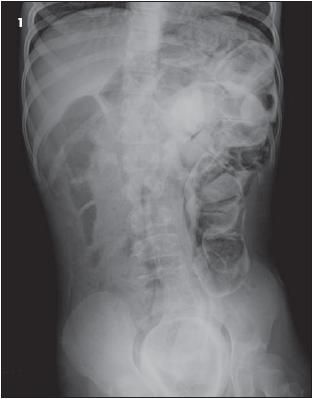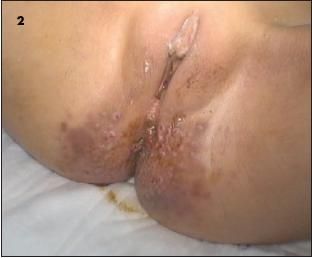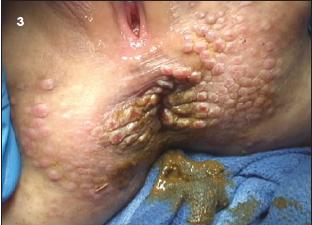Papular Perianal Rash in an 8-Year-Old Girl
An 8-year-old girl is brought to the emergency department by her mother with a complaint of 5 days of worsening constipation and rectal bleeding. For the past week, the girl has had small stools 3 or 4 times a day and crampy abdominal pain. Yesterday, her stools were streaked with a small amount of blood. The mother notes that her daughter spends up to an hour in the bathroom with each bowel movement. In addition, the mother remarks that the girl has a rash in the rectal area and along the inner thighs.
THE CASE
An 8-year-old girl is brought to the emergency department by her mother with a complaint of 5 days of worsening constipation and rectal bleeding. For the past week, the girl has had small stools 3 or 4 times a day and crampy abdominal pain. Yesterday, her stools were streaked with a small amount of blood. The mother notes that her daughter spends up to an hour in the bathroom with each bowel movement. In addition, the mother remarks that the girl has a rash in the rectal area and along the inner thighs. The patient complains of pain in this area. The mother also reports that her daughter has been walking oddly for the past few days and crying.
The patient has no fever, vomiting, or dysuria; however, her oral intake and activity level have been decreased, and her sleep has been poor. She has also had occasional pains in her ankles and hands. There is no disclosure or reported history of abuse.
She has a history of chronic constipation that began when she was about 3 weeks old. The constipation has been treated with over-the-counter fiber supplements with varying success. She takes no other medications. An MRI scan of the abdomen performed at age 3 years to evaluate her constipation was reportedly normal. There is a family history of hypertension but no family history of GI disorders.
The patient, her mother, and her 3 brothers recently moved to the area from Texas. The patient's father did not move with the family and had reportedly been abducted while he was in Mexico.
On physical examination, the child is uncomfortable and appears anxious. She weighs 23 kg (50.6 lb). Distention is noted in the lower left and upper left quadrants; there is diffuse abdominal tenderness with decreased bowel sounds but no hernias. The abdominal radiograph is as shown (Figure 1). Genitourinary examination reveals a very painful erythematous, papular rash in the perianal region and extending to the bilateral buttocks and medial thighs (Figure 2). Stool coats the entire groin area, and a possible fissure is seen near the anus.

Figure 1

Figure 2
Do you suspect abuse-or an underlying medical cause?
Answer: Perianal Pseudoverrucous Papules and Nodules
DISCUSSION
The child was admitted to the hospital, and a GI clean-out regimen was started consisting of enemas and oral polyethylene glycol, administered ultimately via a nasogastric tube. She was given clindamycin intravenously because of the tenderness and erythema in her groin area and concern for cellulitis. Swabs for culture and direct fluorescent antibody staining for herpes simplex virus were obtained; results of both studies were negative.
The child abuse team was consulted to help discern whether the rash might represent another sexually transmitted disease-human papillomavirus (HPV) infection. After the child abuse team evaluated the patient, they concluded that her rash was not consistent with HPV infection. Instead, the rash was identified as perianal pseudoverrucous papules and nodules (PPPN), a type of irritant contact dermatitis. This rare dermatitis has been associated with encopresis (as in this child) as well as with urinary incontinence and colostomy sites.1-3 There is even a report of 2 cases of PPPN caused by excessive application of topical benzocaine.4
Other irritant contact dermatitis conditions that affect the genital region include granuloma gluteale infantum and Jacquet erosive diaper dermatitis. Granuloma gluteale infantum typically appears as nodules in the diaper area in infants. Jacquet erosive diaper dermatitis tends to consist of more ulcers and erosions. Recent literature has suggested that these entities, along with PPPN, may all be part of the same disease spectrum.4
PPPN can be mistaken for HPV infection (hence the term "pseudoverrucous"); however, PPPN differs from HPV infection in several key aspects of the history and physical findings. HPV warts can be present for months to years; typical symptoms are anal itching and, rarely, bleeding or pain in severe cases. Warts are commonly "kissing" (ie, they meet on both sides of the gluteal crease) and vary in size. In contrast, PPPN is very painful and develops only after an irritant (commonly stool or urine) has been present in the area for an extended period. PPPN is usually wet or weepy, and all the lesions tend to be the same size and shape.
Treatment of PPPN is fairly simple: it involves proper skin care and removal of the irritant. Occasionally, in severe cases, topical or oral corticosteroids may be required.
The physicians who cared for this patient during her hospitalization were concerned that she might have a rectovaginal fistula. However, the findings of stool in her vagina were ultimately determined to represent stool that had traveled retrograde into the vagina from the perianal region. Because of the child's significant constipation history, screening tests were performed to rule out inflammatory bowel disease and celiac disease; however, none of these studies revealed any abnormalities. She remained in the hospital until her GI clean-out was complete, and she was sent home with instructions for a strict bowel routine and close GI follow-up. It was anticipated that once her encopresis resolved, in time the PPPN would diminish as well. Figure 3 shows the rash at the time of discharge.

Figure 3
THE KEY POINTS
Although a papulonodular perianal rash in a child should raise concerns for HPV infection and thus for abuse, such a finding may also represent PPPN. To distinguish between these entities, take a careful history of the nature and duration of the rash, including any history of incontinence or soiling. Physical examination findings will also usually distinguish between the 2 entities. Should all else fail, a child abuse consultant should be able to assist with the diagnosis.
References:
- Goldberg NS, Esterly NB, Rothman KF, et al. Perianal pseudoverrucous papules and nodules in children. Arch Dermatol. 1992;128:240-242.
- RodrÃguez Cano L, GarcÃa-Patos Briones V, Pedragosa Jové R, Castells Rodellas A. Perianal pseudoverrucous papules and nodules after surgery for Hirschsprung disease. J Pediatr. 1994;125:914-916.
- Coppo P, Salomone R. Pseudoverrucous papules: an aspect of incontinence in children. J Eur Acad Dermatol Venereol. 2002;16:409-410.
- Robson KJ, Maughan JA, Purcell SD, et al. Erosive papulonodular dermatosis associated with topical benzocaine: a report of two cases and evidence that granuloma gluteale, pseudoverrucous papules, and Jacquet's erosive dermatitis are a disease spectrum. J Am Acad Dermatol. 2006;55:S74-S80.
Recognize & Refer: Hemangiomas in pediatrics
July 17th 2019Contemporary Pediatrics sits down exclusively with Sheila Fallon Friedlander, MD, a professor dermatology and pediatrics, to discuss the one key condition for which she believes community pediatricians should be especially aware-hemangiomas.